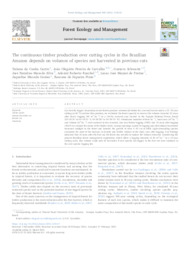The continuous timber production over cutting cycles in the Brazilian Amazon depends on volumes of species not harvested in previous cuts.
The continuous timber production over cutting cycles in the Brazilian Amazon depends on volumes of species not harvested in previous cuts.
Author(s): CASTRO, T. da C.; CARVALHO, J. O. P. de; SCHWARTZ, G.; SILVA, J. N. M.; RUSCHEL, A. R.; FREITAS, L. J. M. de; GOMES, J. M.; PINTO, R. de S.
Summary: Can heavily logged Amazonian dense forests produce commercial timber for a second harvest under a 25?35-year cutting cycle? To address this question, we evaluated the forest capacity to recover the volume extracted 32 years after heavy logging (90 m3 ha?1) in a 144-ha research area located in the Tapajós National Forest, Brazil (03°18?31? to 03°19?21? S; 54°56?28? to 54°56?15? W). Abundance (number of trees ha?1), basal area (m2 ha?1) and volume (m3 ha?1) were assessed in two censuses, one year before logging (1981) and 32 years after logging (2014) to evaluate the status of the timber stock. Canopy openings caused by logging and silvicultural treatments increased sunlight in the forest and boosted the growth of trees 5?45 cm in DBH. Light-demanding species accounted for most of the increase in density and timber volume in the study area after logging. Our findings indicated that 32 years after the first cut, the forest was not able to replace the volume extracted. Considering the present Brazilian forest management regulations, which allow a logging intensity of 30 m3 ha?1 in a 35-year cutting cycle, this volume could only be harvested if new species not logged in the first cut were included in the new species logging list.
Publication year: 2021
Types of publication: Journal article
Unit: Embrapa Eastern Amazon
Keywords: Amazonia, Annual allowable cut, Madeira, Second cut, Timber yields
Observation
Some of Embrapa's publications are published as ePub files. To read them, use or download one of the following free software options to your computer or mobile device. Android: Google Play Books; IOS: iBooks; Windows and Linux: Calibre.
Access other publications
Access the Agricultural Research Database (BDPA) to consult Embrapa's full library collection and records.
Visit Embrapa Bookstore to purchase books and other publications sold by Embrapa.

